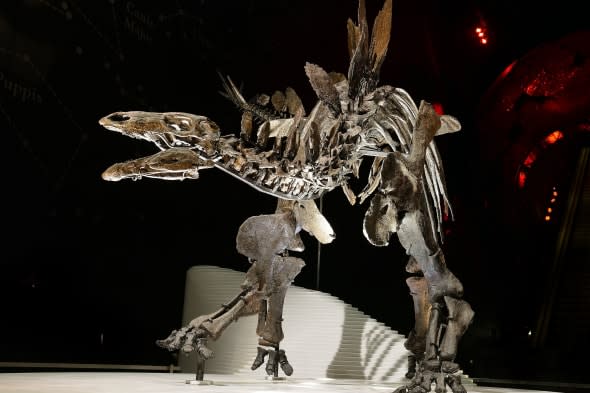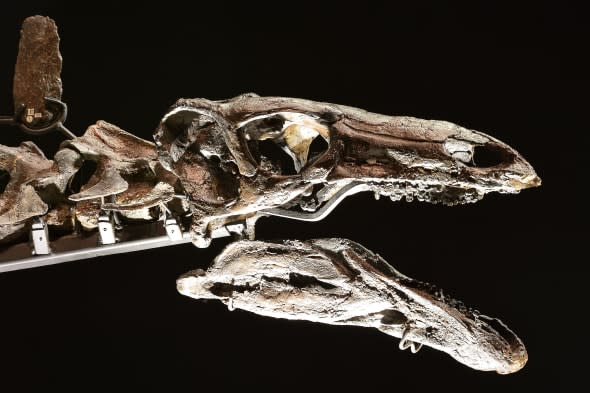World's most complete stegosaurus skeleton finds new home at Natural History Museum

The world's most complete stegosaurus skeleton has been relocated to London's Natural History Museum.
More than 100 million years ago she lumbered around an ancient subtropical forest in Wyoming, ceaselessly chewing plants while keeping her terrifying spiked tail at the ready to swat any predator that dared try its luck.
Today, Sophie the Stegosaurus has a new home, London's Natural History Museum, where her stunning presence dominates the Earth Hall.
With 85% of her skeleton intact, she is the world's most complete specimen of the instantly recognisable dinosaur famous for the huge plates cresting its back and the four spear-like horns on the end of its tail. Words: PA
Although museum scientists do not actually know the sex of their Stegosaurus, "she" has been informally named Sophie after the daughter of the wealthy hedge fund manager whose donation made the acquisition possible.
At 5.6 metres (18 feet) long and 2.9 metres (9.5 feet) tall, Sophie is relatively small compared with the largest of her species which measured up to nine metres (29 feet).

But what she lacks in size she makes up for in beauty.
Poised on a small stage just inside the museum's Exhibition Road entrance with her tail up, front body lowered, and open jaws pointing at arriving visitors, she brings the Cretaceous era alive.
Sophie is the first complete dinosaur specimen to go on display at the Natural History Museum in nearly 100 years.
She joins "Dippy" the Diplodocus, whose massive 26 metre (85 foot) skeleton - a replica rather than the real thing - has stood in the museum's central Hintze Hall since 1905.
Professor Paul Barrett, the museum's chief dinosaur scientist, who found Sophie while attending an international fossil fair in the US, said: "It's an honour to have this extraordinary specimen permanently on display to inspire Natural History Museum visitors.
"Stegosaurus fossil finds are rare. Having the world's most complete example here for research means we can begin to uncover the secrets behind the evolution and behaviour of this intriguing dinosaur species."
Sophie was a young adult when she died 150 million years ago.
Her fossilised bones were discovered in 2003 at Red Canyon Ranch in Wyoming, US, by palaeontologist Bob Simon.
Prof Barrett led a year of negotiations which eventually secured the Stegosaurus for the Natural History Museum despite strong interest from a number of other institutions.
Her cost - likely to be substantial - is not being disclosed at the request of hedge fund manager Jeremy Herrmann who provided most of the money.
A total of 69 other private donors all contributed to the purchase.
The scientific value of the specimen, containing 360 individual bones, is priceless.
Many of the bones have already been laser-scanned and imaged with CT (computed tomography) X-rays to create "virtual" models that can be studied in the form of computer simulations.
Researchers are especially interested in the way Sophie moved and ate, and the function of her 19 bony back plates, which still remains uncertain.

Prof Barrett said: "Although we know Stegosaurus was a plant eater, we don't know exactly what sort of plants it might have been eating or how well it was able to use its feeble looking teeth to eat and support a body weighing a couple of tonnes.
"Another project is reconstructing models of the hind limbs and hips.
"Stegosaurus moved on all fours very slowly, we think.
"It was a fairly unathletic dinosaur.
"A good modern analogue is something like a rhino, although a rhino is capable of short bursts of speed."
The spiked tail is a defining feature of Stegosaurus, and scientists know it was used as a formidable weapon.
"One specimen of Allosaurus - a large two-legged predator dinosaur pre-dating Tyrannosaurus rex by about 80 million years - bears puncture wounds that match the points of Stegosaurus tail spikes.
"An obvious deterrent was the spikes at the end of the tail," Prof Barrett said.
"They were even longer in real life, a quarter to a third longer, because the bones would have been covered in a sheath of horn.
"They were possibly quite sharp and quite nasty things.
"The tail was quite long and muscular and could probably have been swung from side to side with some force."
Turning to the back plates, he added: "The function of the plates is quite controversial.
"An early idea was that they were a form of armour but most people don't believe that any more, because they were quite thin.
"Its possible they provided a kind of passive defence because they would have made the dinosaur look a lot bigger from a distance.
"Alternatively they could have been used as radiators.
"The plates have a very large surface area and we know there were a lot of blood vessels running through them.
"Or they might have been used for display, like a peacock's tail.
"We're going to find out how strong the plates are, and we're modelling how the air might flow around them."
Sophie's skull is one of the few parts of her that has been replaced with a replica for museum visitors.
The real skull is in a number of different pieces and being kept behind closed doors for the scientists to study.
"All the individual bones are separated and can be slotted together like a big meccano set," Prof Barrett said.
"That means we can conduct studies of the skull that would previously have been impossible.
"We can look at the internal joints and work out how hard the jaws would have been able to bite.
"We have carried out CT scans of the skull bones and constructed a virtual model of the skull.
"We're looking at its strength and how responsive it was to different bite forces."
Eating would have taken up most of the dinosaur's time, scientists believe.
The head of Stegosaurus was strikingly small in comparison with its body, containing a brain about the size of a tangerine.
Those tiny jaws would have had to be working almost constantly for the animal to devour enough food.
Sir Michael Dixon, director of the Natural History Museum, said: "We are extremely grateful to the 70 generous donors, with particular thanks to Jeremy Herrmann, who made this iconic acquisition possible.
"It inspires genuine wonder when you see it, but unlike our much-loved Diplodocus cast, this is the real thing.
"We hope that this amazing specimen will inspire a new generation of young visitors to learn more about the natural world and our place within it."
Sophie will be on public display at the museum from today.
Related stories
Canary Islands to host Europe's first underwater museum?
New dinosaur species discovered in Canadian museum
Major new technology gallery opens at Science Museum






